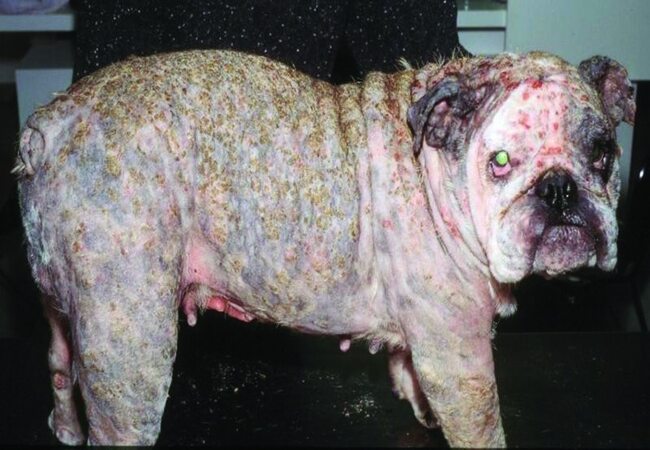2025 Vet Guide to Canine Staph (Pyoderma) Infections – Causes, Diagnosis & Care🩺

In this article
2025 Vet Guide to Canine Staph (Pyoderma) Infections – Causes, Diagnosis & Care🩺
By Dr. Duncan Houston BVSc
💡 What Is Canine Staph (Pyoderma)?
Canine staph infections (pyoderma) occur when common skin bacteria—mainly Staphylococcus pseudintermedius, but also S. schleiferi or S. aureus—overgrow due to skin barrier damage or immune weakness.
🚩 Who Is at Risk?
- 🍼 Puppies & disease‑compromised dogs—less immune defense.
- 🐶 Dogs with allergies, endocrine issues, mange, or urine scald—common predisposing causes.
- 🧴 Breeds with skin folds (e.g., Bulldogs, Pugs) or those overweight—humid areas harbor bacteria.
👀 Clinical Signs
- 🔴 Red, inflamed, crusty or moist lesions; hair loss & itchiness.
- 🛠 Deeper infections: fever, lethargy, pain, draining tracts.
- 🐾 Pododermatitis (paw infections) common—characterized by swelling, discharge, and odor.
🧪 Diagnosis Steps
- Skin cytology—tape or skin smear identifies cocci bacteria with signs of inflammation.
- Culture & sensitivity to determine specific Staph strain and guide antibiotic choice—crucial for MRSP/MRSA.
- Underlying cause investigation (allergies, endocrine, parasites) via diagnostics like skin scrapes, bloodwork, cytology.
🛠 Treatment Strategies
1. Topical Therapy
- ⭐ Medicated shampoos (e.g. 3–4 % chlorhexidine), wipes, mousses several times weekly.
- 🚿 Ointments or sprays (chlorohexidine, gentamicin/betamethasone) for localized areas.
- 🔁 Keep lesions clean, dry & protected—prevents licking & re‑infection.
2. Oral Antibiotics
- 🧪 Cephalexin, cefpodoxime, clindamycin often effective in surface infections.
- 🧬 If MRSP/MRSA identified, use culture-guided agents to combat resistance.
- 💉 Antipruritic support with Apoquel® or Cytopoint® helps reduce itch-induced self-trauma.
3. Treat Underlying Conditions
- 🎯 Control allergies, mange, endocrine causes concurrently to prevent recurrence.
- 🛁 Maintain hygiene: coat brushing, fold cleaning, wound care, environmental sanitation.
📈 Recovery & Prevention
- ✔️ Superficial infections may clear in 2–3 weeks; deeper involvement may take 4–6 weeks.
- ⚠️ Immunocompromised pets often need extended courses and close monitoring.
- 🎯 Prevent recurrence through allergy control, weight management, grooming.
🏡 Ask A Vet App Home Monitoring Tools 📲🐶
- 📆 Reminders for topical baths, antibiotic doses & anti-pruritic treatments.
- 📊 Daily logs: itch level, odor, lesion appearance.
- 📷 Upload lesion images for virtual vet assessment.
- 🔔 Alerts if lesions worsen, become smelly, or systemic signs emerge.
- 📚 In-app guidance: cleaning folds, using medicated products, identifying redness early.
🔑 Key Takeaways 🧠✅
- Staph infections are very common and often secondary to skin barrier issues.
- Confirm diagnosis with cytology + culture to guide effective treatment.
- Combine topical care, oral antibiotics, itch control, and treat underlying conditions.
- Prevention involves hygiene, environment, weight/allergy control.
- Ask A Vet helps owners track lesions, medications, and collaborate remotely with vets.
🩺 Final Thoughts ❤️
In 2025, managing canine staph infections means combining precise diagnostics, appropriate antibiotic use, topical therapy, and resolving underlying conditions. With well-structured home care—supported by reminders, symptom logs, and remote vet review—most dogs experience full recovery and reduced recurrence. Ask A Vet empowers families to monitor healing, follow treatment plans accurately, and seek timely veterinary care ✨🐾.
Visit AskAVet.com and download the Ask A Vet app today to track topical baths, upload lesion photos, set reminders, log symptoms, receive alerts, and get virtual support for your furry friend’s skin health. 📲🐶






